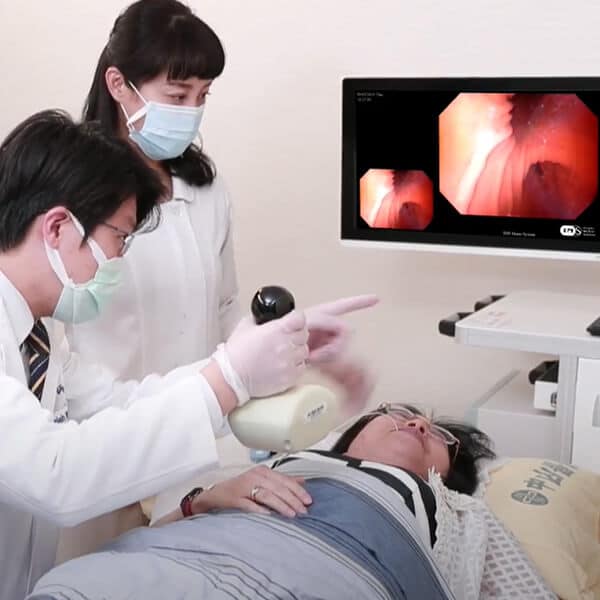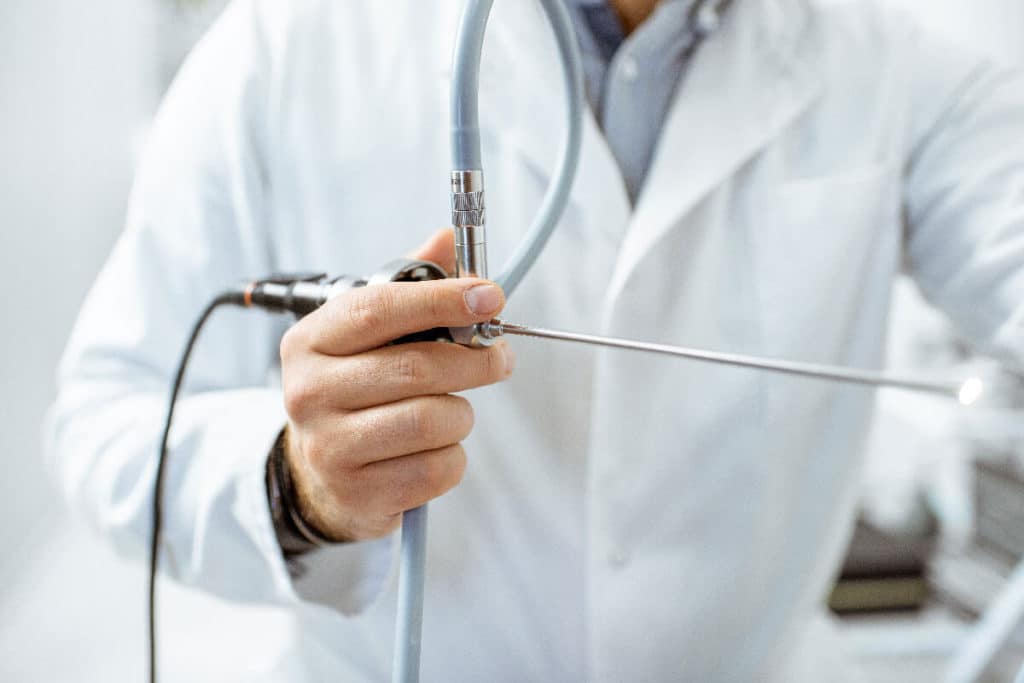Table of Contents
A medical endoscope is a device used for performing endoscopy. Endoscopy is a non-surgical procedure that helps to view and examine the digestive tract. The medical endoscope consists of several components that provide pictures of the digestive tract. It includes:
- A flexible or rigid tube
- A light delivery system that illuminates the specific organ or object which requires inspection. Most commonly the light source is placed outside the body and light is targeted at the site via an optical fiber system.
- A lens system which transmits the image to the viewer. Typically, in case of a fiberscope it uses a bundle of fiberoptics, and in rigid endoscopes it uses a relay lens system.
- An eyepiece: Advanced instruments use videoscopes without any eyepiece. A camera transmits image displaying it on the screen that is used for image capture.
- An additional channel to facilitate entry of medical instruments
In some situations, patients may undergo sedation which has its own challenges and risks.
What are techniques of using medical endoscope?
Medical endoscopy is widely used and is a minimally invasive technique indicated for diagnostic purpose and surgical techniques.
- Insertion of the endoscope takes place via the mouth if examination of stomach and bronchial tubes is required.
- Through the nostrils in case of assessment of nostrils, sinuses or vocal cords.
- Through the colon if examining colon
Certain situations may require additional intervention to examine the target area thoroughly. For example, sometimes a small incision may be needed to insert the endoscope such as in abdominal region (laparoscopy).
What are the different types of medical endoscopes?
There are three kinds of medical endoscopes:
Rigid optical endoscope
It consist of a rigid rod with lenses. At one end of the endoscope there is lens, while on the other end a socket for connecting the eyepiece and the light source. It also provides additional area to attach a video camera head onto it. Rigid endoscopes usually have metal tubes, consisting of the lenses, and light channels. They are available in a wide range of external diameters ranging from 1-12mm.
The fiberscope
It is also called as flexible optical endoscope. The mechanism of action for rigid and flexible optical endoscope is similar, and the only difference is of stem which is flexible in fiberscope due to presence of an optical fiber. Thus, it is easier to access sinuous areas, especially few parts of the larynx. On the other hand, the stem should be used gently as the stem is thin, flexible and fragile.
Video-endoscope
This type of endoscope has flexible rod and a CCD sensor at its end which provides video images. It can also have one or more working channels in its stem usually for the placement of endoscopic instruments. This is useful in polypectomy, prostate enucleation etc. The video-endoscope should be handled delicately due to the fragility of the sensor located at the end. Few video laryngoscopes can be rigid. They consist of a blade and can be integrated with a video monitor to allow quick viewing, particularly in case of emergency intubation.
What are the main applications and advantages of medical endoscopes?
Rigid endoscopes
- These are the oldest types of endoscopes. Rigid endoscopes are used in majority of surgical endoscopic applications enabling visualization of organs, vessels and any pathologic changes in the structures.
- Most of the endoscopes do not require any additional incisions and provide a clear view of the internal components.
- Depending on few parameters and design criteria the image results can vary. This includes viewing angle, image brightness, image size, depth-of-field and distortion. Hence, all these features should be appropriately balanced. Common indications for rigid endoscopes include rhinoscopy (nose), laparoscopy (abdomen) and cystoscopy (urinary bladder).
Virtual endoscopy such as virtual colonoscopy and virtual bronchoscopy helps the clinicians to examine internal structures in a non-invasive manner by using advanced imaging techniques.
Robotic flexible GI endoscopy
In recent times, robotic platforms in endoscopy are becoming popular to allow best possible outcome and minimal risks related to use of endoscopes. Current endoscopic devices have their own diagnostic and therapeutic limitations which will be overcome with the help of robotic assisted surgery. Robotic platforms will improve the safety and precision of the traditional tools making them more efficient and reliable.
Robotic platforms have several benefits:
- In COVID-19 situation, use of robotic device will allow to maintain a safe distance between the patient and operator by using remotely controlled devices. This will result in less risk of infection as there will be no droplet contact and aerosol contamination
- Robotic devices are simple and easy to operate.
- Reduce the training times
- Useful in cases where fine motor skills are required which are beyond the scope of human dexterity.
- Improves precision and control over the device, hence less risk and complications observed with the robotic platforms.
- They will lower patient discomfort by reducing the torque and force applied at the target area.
- Better image will be obtained due to precise control and management of the device compared to the conventional techniques.
What are the recent trends?
Endoscopic ultrasonography
- Endoscopic ultrasonography (EUS) has an ultrasound transducer of high-frequency which is attached at the tip of the endoscope. This provides high-resolution images of the gastro-intestinal wall and adjoining structures.
- EUS-guided fine needle aspiration (EUS-FNA) is a recent technique that uses a thin needle allowing aspiration of the tissue under the ultrasonographic guidance.
- There are few other therapeutic procedures that can be performed under the guidance of real-time ultrasound, such as EUS-guided celiac plexus blockage and EUS-guided drainage.
Wireless capsule endoscope
It is basically a diagnostic tool. The system has a disposable video-recorder capsule and a 7-hour battery which transmits the recorded images to a data recorder. This data recorder is attached to patient’s waist. There is a computer workstation with software facilitating reviews and interpretation of results.
WCE can be conducted in an outpatient setting. The capsule is ingested after a 10-12 hour fasting period without sedating the patient. It moves through the small intestine through peristalsis.

Percutaneous endoscopic gastrostomy
- Percutaneous endoscopic gastrostomy (PEG) is a type of endoscopic procedure that allows placement of tube through the abdominal wall. Different indications for PEG include cancer of the oropharynx, impaired swallowing conditions (stroke), and tumor of the larynx and esophagus.
- It is also beneficial for patients with malignant bowel obstruction. This endoscopic technique should be avoided if peroral feeding is expected to resume in a month. Application and case selection of PEG is debatable.
In this method when the radiation targets the tissue at a specific wavelength, unique molecules known as fluorophores will release the absorbed energy in the specific radiation form. Based on the spectrum analysis and assessment of the emitted radiation, the nature of the tissue can be characterized. The final fluorescent image when overlapped with the traditional image will help in the diagnosis.
What things should be considered while using medical endoscope?
Medical endoscopy is a safe procedure, and the risk associated with the use of endoscopes is generally low. In some rare situations few complications can be seen such as:
- Infection at the site where endoscope was used for examining the particular area. This may require treatment with antibiotics.
- Piecing or tearing of a tissue or organ.
- Bleeding which may need surgery to repair the damaged tissue.
In some cases, sedation may be needed which can sometimes cause adverse events such as:
- Breathing problems
- Low blood pressure (hypotension)
- Burning sensation at the injected site
- Feeling sick
Conclusion
Endoscopes are an integral component in the medical field. They allow a clear image of the internal structures such as organs, tissues and vessels etc. With recent advances in technology, several new developments have led to the introduction of fiberscope, video-endoscope, ultrasound and robotic assisted surgical intervention. Different kinds of endoscopes are used for a wide range of applications in order to allow successful outcome in diagnostic and therapeutic purposes. A detailed and thorough examination of the target site is possible with endoscopes, which should be selected based on individualized needs and requirements.







